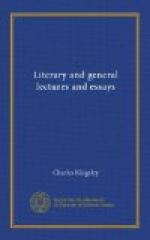The true value of the book is, that though not exhaustive of the subject, it is suggestive. It affords the best, indeed the only general, sketch of the subject which we have in England, and gives therein boundless food for future thought and reading; and the country parson, or the thoughtful professional man, who has no time to follow out the question for himself, much less to hunt out and examine original documents, may learn from these pages a thousand curious and interesting hints about men of like passions with himself, and about old times, the history of which—as of all times— was not the history of their kings and queens, but of the creeds and deeds of the “masses” who worked, and failed, and sorrowed, and rejoiced again, unknown to fame. Whatsoever, meanwhile, their own conclusions may be on the subject-matter of the book, they will hardly fail to admire the extraordinary variety and fulness of Mr. Vaughan’s reading, and wonder when they hear—unless we are wrongly informed—that he is quite a young man—
How one small head could compass all he knew.
He begins with the mysticism of the Hindoo Yogis. And to this, as we shall hereafter show, he hardly does justice; but we wish now to point out in detail the extended range of subjects, of each of which the book gives some general notion. From the Hindoos he passes to Philo and the neo-Platonists; from them to the pseudo-Dionysius, and the Mysticism of the early Eastern Church. He then traces, shrewdly enough, the influence of the pseudo-Areopagite and the Easterns on the bolder and more practical minds of the Western Latins, and gives a sketch of Bernard and his Abbey of Clairvaux, which brings pleasantly enough before us the ways and works of a long-dead world, which was all but inconceivable to us till Mr, Carlyle disinterred it in his picture of Abbot Sampson, the hero of “Past and Present.”
We are next introduced to the mystic schoolmen—Hugo and Richard of St. Victor; and then to a far more interesting class of men, and one with which Mr. Vaughan has more sympathy than with any of his characters, perhaps because he knows more about them. His chapters on the German Mysticism of the fourteenth century; his imaginary, yet fruitful chronicle of Adolf of Arnstein, with its glimpses of Meister Eckart, Suso, the “Nameless Wild,” Ruysbroek, and Tauler himself, are admirable, if merely as historic studies, and should be, and we doubt not will be, read by many as practical commentaries on the “Theologia Germanica,” and on the selection from Tauler’s “Sermons,” now in course of publication. Had all the book been written as these chapters are, we should not have had a word of complaint to make, save when we find the author passing over without a word of comment, utterances which, right or wrong, contain the very keynote and central idea of the men whom he is holding up to admiration, and as we think, of Mysticism itself. There is, for instance, a paragraph attributed to Ruysbroek, in p. 275, vol. i., which, whether true or false—and we believe it to be essentially true—is so inexpressibly important, both in the subject which it treats, and in the way in which it treats it, that twenty pages of comment on it would not have been misdevoted. Yet it is passed by without a word.




